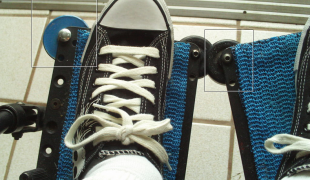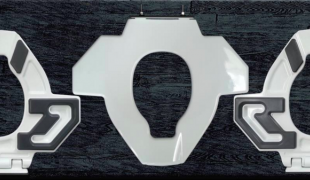- 8148
- 555
- 12
- 17
- 0
- Help Ukraine
About the solution
The invention is equipped with a generator to provide power, and the internal structure can provide a traction force for the users and help them climbing. The force is adjustable so that the users can choose to climb stairs at suitable speeds.
"When I was in 6th Grade, I went to my grandparent’s house, as it’s an old community and there was no elevator inside the building, it has been extremely difficult for my grandparents to climb the stairs”, said Chen Ding. "At that time, I was wondering whether we could install equipment on these stairs without elevator, and make the elders climb up the stairs effortlessly”.
While entering middle school, Chen Ding shared the idea with his supervisor, Mr. Zhang. After listening carefully to Ding’s thoughts, Zhang considered it would be a very meaningful solution, and encouraged Ding to start working on the prototype under his guidance.
From the design, material selection, to 3D modelling, 3D printing, debugging & improvement, the whole process lasted about six months. Finally, in the middle of 2017, they’ve successfully built a booster device for stair-climbing, which is adaptable to the stair handrails.
Having won international awards for several times, Chen Ding’s “stair-climbing booster” won the Gold Award of Youth Group in the 32th INPEX Innovation Competition in Pittsburgh, US, in 2017.
"In fact, there are staircase handrails available on the market, but the price is as expensive as about 1500 EUR, however the performance is still not so good – some lack the driving force and other are not chargeable”, said Ding’s supervisor, Mr. Zhang.
Ding and Zhang’s ultimate goal is to create high-quality and cost affordable stair-climbing boosters, with the user’s freedom to change the driving force.
Adapted from: http://www.sohu.com/a/162531757_669483
This solution shall not include mention to the use of drugs, chemicals or biologicals (including food); invasive devices; offensive, commercial or inherently dangerous content. This solution was not medically validated. Proceed with caution! If you have any doubts, please consult with a health professional.
DISCLAIMER: This story was written by someone who is not the author of the solution, therefore please be advised that, although it was written with the utmost respect for the innovation and the innovator, there can be some incorrect statements. If you find any errors please contact the patient Innovation team via info@patient-innovation.com
-
-
580
-
0
-
10158

Man adds footpads to his wheelchair to protect his feet
WALKING WITH A WALKING AID: Walking with a walking aid
Traveling
Urban exploration
Paralysis
Walking Aid (wheelchair/walker/crutches)
Assistive Daily Life Device (to help ADL)
Managing pain
Promoting self-management
Restoring Blood Circulation
Preventing (Vaccination, Protection, Falls, Research/Mapping)
Dermatology
General and Family Medicine
Neurology
Orthopedics
Pediatrics
Rheumatology
United States
-
-
-
352
-
0
-
3766

Hip & co- a mum's invention for hip dysplasia
CAREGIVING
BODY BALANCE: Maintaining body balance
STANDING UP: Standing up from a seated position
WALKING WITH A WALKING AID: Walking with a walking aid
WALKING: Walking
Hip Dysplasia
Assistive Daily Life Device (to help ADL)
Walking Aid (wheelchair/walker/crutches)
Difficulty walking or moving
Muscle weakness
Limited range of motion
Muscle pain or stiffness
Loss of muscle coordination
Muscle cramps or spasms
Joint deformity
Joint redness or warmth
Swelling or inflammation
Difficulty bearing weight
Numbness or tingling in the extremities
Frequent falls
Joint pain or swelling
Restoring mobility
Managing pain
Promoting self-management
Preserving Organ Function
Recovering from Traumatic Injuries
Maintaining Balance and Mobility
Raise awareness
Caregiving Support
General and Family Medicine
Orthopedics
Pediatrics
Australia
-
-
-
355
-
0
-
5855

Toilet seats with wings for easier transfers
(SELF)-CARE: USING THE TOILET: Using the toilet independently
STANDING UP: Standing up from a seated position
Spinal Cord and Nerve Root Disorders
Paralysis
Bone Disorders (Decalcification, Bone Deformity, Bone Fracture, Bone Infection)
3d Printed
Assistive Daily Life Device (to help ADL)
Difficulty coordinating movements
Stiffness or rigidity (difficulty moving)
Paralysis of the legs and lower body
Muscle weakness
Limited range of motion
Loss of muscle coordination
Difficulty bearing weight
Difficulty standing from a seated position
Promoting self-management
Caregiving Support
General and Family Medicine
Neurology
Orthopedics
Public Health
Rheumatology
Aging
United States
-
 en
en